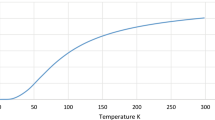Summary
-
1.
The solubility of the elements in titanium follows a pattern similar to that characterizing the solubility of the elements in other metals, such as iron, nickel, and chromium.
-
2.
The formation, or non-formation, of solid solutions in binary titanium systems is associated with the relative similarity, or dissimilarity, in the properties of the elements, as indicated by Mendeleev's periodic system.
-
3.
Metals which are titanium analogs (zirconium and hafnium), or are closely situated in Groups V and VI, and which differ little in atomic diameter and have isomorphous structures, are able to form continuous solid solutions with titanium.
-
4.
The metals that are the most removed from titanium-elements of Groups I and II, and the Group VIII-have a lower tendency to form solid solutions. Most of the Group I and II metals do not interact with titanium in the liquid or solid state, and do not form solid solutions. Group VIII metals form only limited solid solutions.
-
5.
Elements of low atomic diameter (H, C, N, O) are able to form solid solutions of the interstitial type in low concentration, and to form also interstitial compounds: hydrides, carbides, nitrides, and oxides of titanium.
-
6.
The regularities established for the solubilities of the elements in titanium can be applied to the examination of the solubilities of the elements in the titanium analogs zirconium and hafnium. This will facilitate the general consideration of the phase diagrams of zirconium and hafnium systems, the great majority of which have not been studied.
Similar content being viewed by others
Literature cited
G. P. Luchinsky, Chemistry of Titanium, State Chem. Press, Moscow, 1941,
Gmelin's Handbuch der anorg. Chem., System Number 41, Titan, 1951.
M. P. Slavinsky, Physicochemical Properties of the Elements, Metallurg. Press, Moscow, 1952, p. 244.
A. E. Van-Arkel, Reine Metalle, Berlin, J. Springer, 1939.
J. Barkdale, Titanium, Ronald Press, N. Y., 1949.
N. V. Ageev, Papers Read at a Conference on the Theory of Alloys, Acad. Sci. USSR Press, Moscow, 1952, p. 77.
I. I. Kornilov, Papers Read at a Conference on the Theory of Alloys, Acad. Sci. USSR Press, Moscow, 1952, p. 77.
I. I. Kornilov, Iron Alloys. II. Solid Solutions of Iron. Acad. Sci. USSR Press, 1951.
I. I. Kornilov, Bull. Acad. Sci. USSR, Div. Chem. Sci., 1953, No. 5.
M. C. Guillan, A. D., J. Inst. of Met., 79, 5, 371 (1951).
H. R. Ogden, and R. J. Jaffee, J. Inst. of Met., 79, 338 (1951).
E. S. Bumps, H. D. Kessler and M. Hansen, J. Inst. of Met., 6, 610 (1952).
I. I. Kornilov, Proc. Acad. Sci. USSR, 73, No. 3, 495 (1950).
P. Duwer, J. Inst. of Met., 5, 525 (1952).
J. D. Fast, J. of applied phys., 23, No. 3, 350 (1952).
H. K. Andenstedt, J. R. Teguignot and J. M. Raymer, Trans. Am. Soc. of Met., 44 990 (1952).
M. Hansen, E. Kamen, H. Kessler and D. McPherson, J. Inst. of Met., 3, 881 (1951).
D. J. Maykuth, H. B. Ogden, and R. J. Jaffee, J. Inst. of Met., 5, No. 2, 238 (1953).
F. B. Cuff, W. J. Grant and C. T. Floe, J. Inst. of Met., 4 (8), 848 (1952).
P. Duwer, J. Inst. of Met., 3, No. 9, 765 (1951).
D. J. Maykuth, H. R. Ogden and R. J. Jaffee, J. Inst., of Met., 5, 2, 225 (1953).
R. J. Van Thyne, H. D. Kessler and M. Hansen, Trans. Am. Soc. of Met., 42, 974 (1952).
J. R. Long, E. T. Hayes, D. Root and C. E. Armantrout, Bureau of Mines, Rep. of Inv., No. 4463 (1949).
H. Margolin, E. Ence and F. Nielsen, J. Inst. of Met., 5, 2, 243 (1953).
A. Joukainen, W. J. Grant and C. F. Floe, J. Inst. of Met., 4, 7, 766 (1952).
Ya. S. Umansky, Bull. Sector of Phys. Chem. Analysis, 6, No. 1, 127 (1943).
R. J. Jaffee, H. Ogden and D. Maykuth, J. Inst. of Met., 188, p. 1261 (1950).
M. Ostwald, Mètaux et corrosion, 27, 77 (1952).
M. Hansen, H. D. Kessler, and D. McPherson, Trans. Am. Soc. of Met., 44, 518 (1952).
C. M. Granighead, O. W. Simmon and L. W. Eastwood, 188, No. 3, 514, (1950).
P. Pietrokowsky, J. Inst. of Met., 4, 211 (1952).
H. Nowotny and J. Pesl, Monatsch., 82, 386 (1951).
R. J. Jaffee, J. Inst. of Met., 1, 646 (1949).
L. D. Jaffee and R. K. Pitler, J. Inst. of Met., 188, 11, 1496 (1950).
H. Nowotny and J. Pesl, Monatsch., 82, 344 (1951).
E. S. Bumps, H.-D. Kessler and M. Hansen, Trans. of Am. Soc. for Met., 45, 1008 (1953).
P. Erlich, Z. anorg. Chem., 247, 53 (1951).
Th. Redden and J. Field, Steel., No. 129, 21, 88 (1951).
Author information
Authors and Affiliations
Rights and permissions
About this article
Cite this article
Kornilov, I.I. Solubility of the elements in titanium. Russ Chem Bull 3, 329–335 (1954). https://doi.org/10.1007/BF01167807
Received:
Issue Date:
DOI: https://doi.org/10.1007/BF01167807




